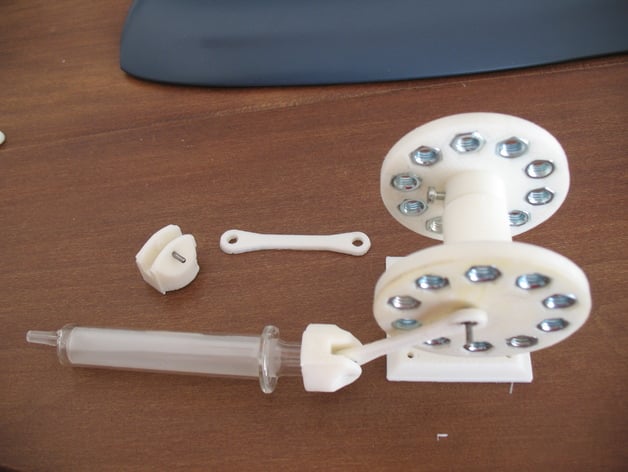
3D printed alpha Stirling engine
thingiverse
In this project, you will need 2x5ml glass syringes, 20xM6 nuts, 2xM3 bolts, a 3mm rod axis, and four 2mm rods. Additionally, you'll require 4x2mm ball bearings, 2x3mm ball bearings, several PLA meters, two pieces of wood, one candle, and 10cm of 3mm ID silicon tubing. With these materials, you can create a (not yet) beautiful, fully functional 3D printed Stirling engine. You can view a video of it in action at http://youtu.be/NecriSICN7w. Please also see the #2 motor at http://www.thingiverse.com/thing:278422. To assemble, print all parts in PLA using Slic3R with an infill density of 0.5. Ensure that all holes are drilled to exact diameter: main axis (3mm), syringe heads and wheel pin (2mm), main axis ball bearing (6.5mm), and head rod ball bearing (5mm). Before printing the inertia wheels, test two pieces (M3 and M6) to ensure the nuts fit correctly into the holes. Adjust size in .scad files as needed. The M6 nuts provide inertia to the wheels and should fit smoothly into the hexagonal holes; if there's play, use a soldering iron to melt the PLA lip and seal the nut in place. The syringe heads also fit smoothly and can be easily unmounted. Run the pistons using car repair very thin sandpaper. Unfortunately, the support of the two syringes cannot be printed as the syringe body may become quite hot; a thermal insulation solution must be found. The current wooden support is ugly but serves as a proof of concept demonstration.
With this file you will be able to print 3D printed alpha Stirling engine with your 3D printer. Click on the button and save the file on your computer to work, edit or customize your design. You can also find more 3D designs for printers on 3D printed alpha Stirling engine.
